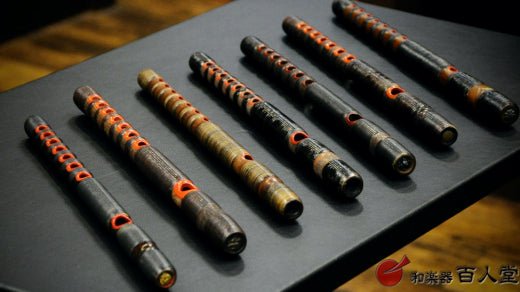From old Noh pipes of the Edo period to new Noh pipes made by Showa-era flute makers, we have Noh pipes from every era.
You can try out the flute by visiting the store.
Each Noh flute has its own unique sound and blowing comfort.
Please take this opportunity to experience the real pleasure of the Nohkan.
All of our Noh-kan have been completed under the care of a flute maker.
[What is Noh-kan?]
The Noh-kan is a Japanese flute used in Noh, Kabuki, nagauta, festivals, and other musical performances. It does not have a Western musical melody, but rather a verse pattern based on shoka(*), which is played rhythmically and powerfully.
(*)Shoka...A form of shoka in which the way a sound is heard is written in katakana notation, such as "Ohiyaraarihiuiahiuiahiu-rololaa-" (*)Shoka is a form of shoka in which the highs and lows of a sound are written in katakana notation. Noh-kan shoka have high and low notes, but they are not absolute melodies; they are more like verses, with the emphasis on nuance. However, the beat (rhythm) is extremely strictly prescribed.
Total length of about 39 cm. The outer diameter of the pipe is about 3 cm. Material: bamboo. The head section from the tip to the mouth of the instrument is often made of thick-jointed male bamboo such as madake, which is joined with thin-jointed shinodake (female bamboo). There are seven finger holes along the same line.
Although the Noh-kan has high and low tones, its middle range is narrower than the usual scale, creating a unique sound shift. The overtones are greatly amplified due to the overlap of the blowing breath sound (noise) in addition to the instrumental pure sound. These elements form a unique tonal character that transforms the atmosphere of the stage as soon as it begins to sound. The high-pitched, high-pitched high notes (hishigi) unique to the Noh flute have a high frequency sound that exceeds the range of human hearing, adding an unparalleled power that is not found in other flutes.
The Noh-kan is also called a "flute for sending down the gods," and is said to have its roots in the iwabue, a stone flute used in rituals during the Jomon period.
On the Noh stage, the hishigi is blown to lure gods, the dead, and other unworldly characters to the stage.
This is why it is said to be a direct descendant of the stone flute.
The Noh flute is a solidly molded, durable flute, and the more it is played, the richer and richer its sound becomes. It is said that the Noh-kan shows its full potential after 100 years of production, and it is not unusual for the Noh-kan used by flutists on stage to be more than 300 years old.
It is important to keep the flute in good condition by storing it carefully and breathing into it continuously.
From old Noh pipes of the Edo period to new Noh pipes of the Showa period, there are Noh pipes rich in individuality.

Tags: all 管楽器
